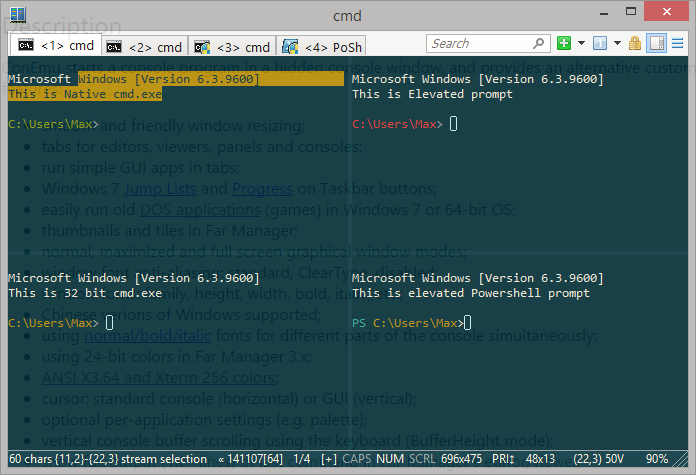macos关闭微软office的自动更新
cd /Library/Application\ Support/Microsoft/MAU2.0
sudo chmod 000 Microsoft\ AutoUpdate.app设置权限到最低或者直接删掉, 这玩意烦得一逼, 还经常更新失败.
cd /Library/Application\ Support/Microsoft/MAU2.0
sudo chmod 000 Microsoft\ AutoUpdate.app设置权限到最低或者直接删掉, 这玩意烦得一逼, 还经常更新失败.
打开PowerShell
Get-WindowsCapability -Online | ? Name -like 'OpenSSH*'Add-WindowsCapability -Online -Name OpenSSH.ClientAdd-WindowsCapability -Online -Name OpenSSH.Server平时用于服务器维护只要安装OpenSSH.Client, 然后就可以像linux环境一样直接用ssh scp等命令了.
类似xshell这种玩意没啥必要安装了.
PS: Windows2019 server可以安装, 之前的2016 2012不能默认直接安装, 需要下载安装包.
先在机器上安装好Centos7, 然后正常启动会遇上Kernel panic无法启动的问题.
这个问题的主要原因是Centos7默认的Kernel 3.10不支持Ryzen, 需要安装5.2以上版本才能支持.
由于系统无法正常启动,这个时候需要用iso启动一个Rescue系统进去安装内核.
用Centos7的Rescue或者用systemrescuecd都可以.
启动好Rescue后的处理步骤大致如下
mount /dev/磁盘分区 /mnt ; cd /mnt
mount -o bind /dev dev/
mount -o bind /sys sys/
mount -o bind /proc proc/
mount -o bind /sys sys/
chroot /mnt
chroot后就可以用yum进行安装高版本的内核了.
参考文章链接http://kvm.la/1385.html
grub2-mkconfig --output /boot/grub2/grub.cfg
如果是chroot进去后可以用mknod创建文件
mknod -m 666 /dev/random c 1 8
mknod -m 666 /dev/urandom c 1 9下载连接http://dl.kvm.la/windows/IPMIToolWin.zip
从浪潮的网站上看到一个windows的ipmitool测试了一下正常可用,
在文件属性和命令看了一下,貌似是intel编译放出来的, 相对ipmiutil来说多了一个常用的工具选择.
原压缩包直接把文件拖了下来加了个一键安装IMB的脚本.
cat IPMIToolWin/install_driver.cmd
if "%PROCESSOR_ARCHITECTURE%"=="x86" goto x86
if "%PROCESSOR_ARCHITECTURE%"=="AMD64" goto x64
exit
:x64
cd imbdriver\x64\
Install C:\IMBDRV\Test
exit
:x86
cd imbdriver\x86\
Install C:\IMBDRV\Test浪潮的网站出处连接:http://www.4008600011.com/archives/15141
Centos7.8后可以安装官方的5.4内核
yum -y update centos-release yum install -y yum-utils epel-release yum-config-manager --enable centos-kernel yum install kernel -y
确认升级完重启, 可以卸载3.10的内核了.
yum remove $(rpm -qa | grep kernel | grep "3\.10")
ip route replace default via 网关IP dev eth0 src 出口IP
若为同 C 段 IP,可以将其设置为函数:
# cat ~/.bashrc
function setip() {
echo "ip route replace default via 192.168.1.1 dev eth0 src 192.168.1.$1"
ip route replace default via 192.168.1.1 dev eth0 src 192.168.1.$1
sleep 1
curl ip.sb
}
# source ~/.bashrc
# setip 2摘取自:https://www.myluoluo.com/linux-set-out-ip.html
1.修改路由表指定默认路由源ip,也可设置metric优先级指定出口ip:
ip route change default via 192.168.1.1 dev eth0 src 192.168.1.9
2.也可使用iptables snat,扩展可对目标ip、端口、应用软件等单独指定出口ip。
iptables -t nat -I POSTROUTING -o eth0 -d 0.0.0.0/0 -j SNAT --to-source 192.168.1.9
摘取自:https://www.haiyun.me/archives/1399.html
经常用原生的*nix环境后就回不去了, windows下的终端软件很多,但都不怎么感觉上手.
在windows10支持linux子系统后, 系统自带了常用的ssh scp rsync sftp等等常用命令后,类似于xshell这种更加显得鸡肋了.
在MACOS下的iTerm2相当的好使, 前些时候发现了ConEmu和iTerm2挺像的, 简洁干净利落.
在用户目录下把.ssh/id_rsa私匙存储好了, 基本上达到了无差别使用.
官方主页:https://conemu.github.io/
github源码主页:https://github.com/Maximus5/ConEmu
最新发布版本页面: https://github.com/Maximus5/ConEmu/releases

一般人买一个, 而我就不一样了, 买了2个.
包装盒挺大, 开盒后就一个4根线的路由器和 12v-1A的 DC电源适配器.
一个机器送了2张“集流物联”的物联网sim卡, 电信联通各一张,等于一起4张.
之前没注意, 开箱后才发现向日葵花生壳/蒲公英是一家子.
2个LAN口, 1一个WLAN口, 都是100Mbps的.
一个4G卡插槽, 插卡后基本上就能上网.
貌似只有2.4G的wifi
具体网速能跑多少也没测试, 整体是一个低端小众需求的产品.
简单扫了下端口
PORT STATE SERVICE REASON 53/tcp open domain syn-ack ttl 64 80/tcp open http syn-ack ttl 64 5000/tcp open upnp syn-ack ttl 64 50001/tcp open unknown syn-ack ttl 64
看到5001端口上有openwrt的字样
HTTP/1.1 501 Not Implemented Content-Type: text/html Connection: close Content-Length: 149 Server: OpenWRT/Oray UPnP/1.1 MiniUPnPd/1.8 Ext:
个人感觉: screen比较常用, picocom比较好用, minicom比较一般
picocom /dev/ttyUSB0 screen /dev/ttyUSB0 minicom /dev/ttyUSB0
centos7早前的版本内核kernel和glibc有ssh漏洞, 不需要密码直接可以进入服务器.
但总有一些人有奇怪的需求指定要低版本或者指定版本的, 然后自己又无视漏洞导致一堆问题又说服务器不稳定.
替换掉openssh-server后建议把kernel和glibc给升级一下.
yum install -y epel-release yum install -y dropbear systemctl enable dropbear dropbearkey -t ecdsa -f /etc/dropbear/dropbear_ecdsa_host_key echo "OPTIONS='-p 22'" >/etc/sysconfig/dropbear
这里默认的端口是22, 也可以改成你想要的端口.
手动启动一个临时的ssh服务端口
dropbear -p 2222
从2222端口连接进去后 停止sshd的服务,然后启动dropbear完成替代.
systemctl stop sshd systemctl start dropbear
确认无误后可以禁用sshd自动启动
systemctl disable sshd
1、dis interface brief #显示端口详细信息
<Quidway>dis interface brief
2、display mac-address #来查看端口下的MAC
<Quidway>dis mac-address
3、display arp #找IP对应的MAC,通过IP后面的端口号就可以知道二层某个端口下所连接的设备信息。
<Quidway>dis arp
查看子卡的运行状态,可以用命令 display device
查看设备复位情况,可以用命令 display reboot-info
查看设备温度,可以用命令 display temperature all
查看设备的告警信息,可以用命令 display alarm urgent
查看内存占用情况,可以使用 display memory-usage
查看日志信息,可以用 display logbuffer 或者 display trapbuffer
保存命令 save stack config和 save all
centos8上epel源码仓只有2.0.8可以装,只能编译安装了
yum install -y flex bison readline-devel ncurses-devel flex make wget https://bird.network.cz/download/bird-1.6.8.tar.gz -O - | tar xz cd bird-1.6.8 ./configure --prefix=/ --bindir=/ make
cli下查看
show virtual-chassis
登陆ssh后把/config/vchassis/目录下的配置文件删除.
root@switch:RE:0% cd /config/vchassis/ root@switch:RE:0% ls vc.db vc.param vc.tlv.db vc.tlv.db.0 root@switch:RE:0% rm -rf ./*
解决办法
yum install --releasever=8 centos-linux-release